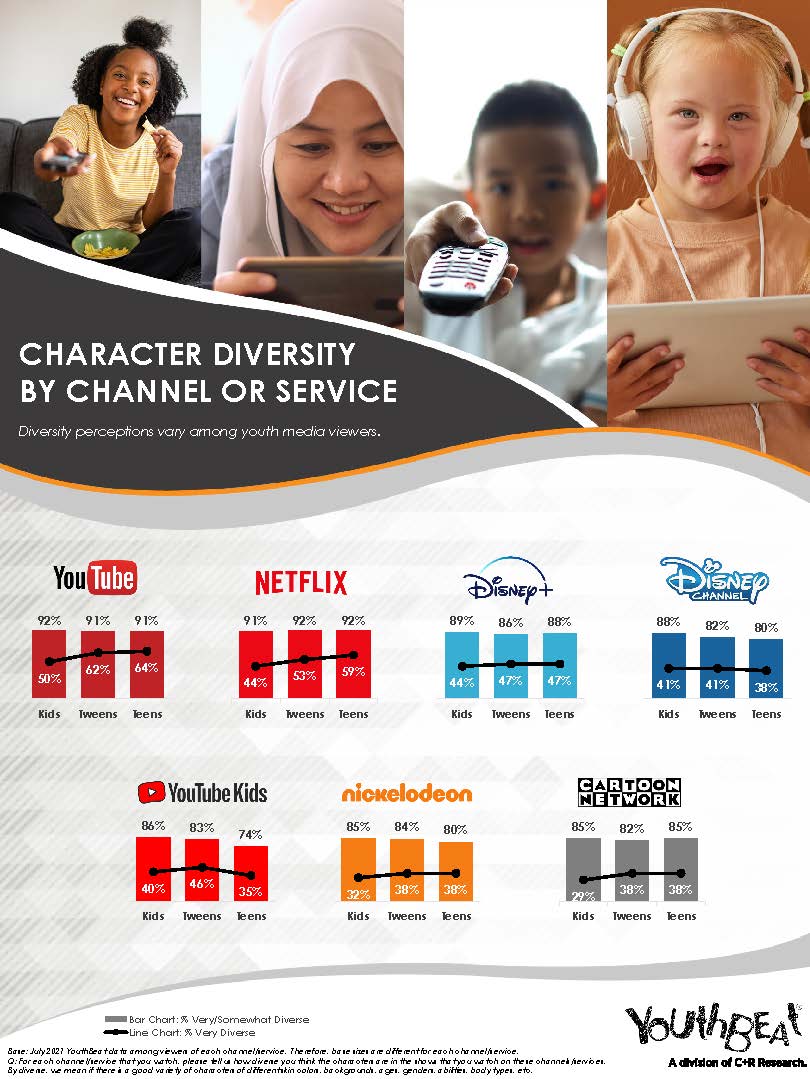
How Much Diversity Is Enough In Kids Media?
Filed Under: Youth & Family

Mary McIlrath
Senior Vice President, C+R Alum
One of our media clients recently reached out to the YouthBeat® team about kids’ perceptions of the diversity in TV programming that is available to them. It’s an interesting topic, and one that we’ve been writing about in our Trendspotters for several years. We’ve been taking note of not just the inclusion of ethnicities and LGBTQ+ characters, but also autism, food-challenged characters, homelessness, and differing abilities that require things like wheelchairs.
So we asked our panelists, “For each channel/service that you watch, please tell us how diverse you think the characters are in the shows that you watch on these channels/services. By diverse, we mean if there is a good variety of characters of different skin colors, backgrounds, ages, genders, abilities, body types, etc.?” Our infographic below illustrates that the Top 2 Box scores (very/somewhat diverse) are much higher than the Top Box (very diverse) for viewers of each channel/service. Of course, Top 2 includes Top, so not a shocker—it’s the magnitude of the differences that are of interest to us.
Our take: don’t be fooled by the Top 2 Box scores into thinking that kids’ media is sufficiently diverse. We always take kids’ responses with a grain of salt—they have a positivity bias, and sometimes “somewhat” can mean “I don’t know/I never thought about it/not really, but I don’t want to be impolite.” We can say for certain that today’s youth are all about inclusivity and wanting the people they know to feel accepted. When books and movies like Wonder, Luca, or Zootopia come out, that normalizes differences in viewers and makes youth less awkward when they encounter real-life people who are different from them.
We’re routinely inspired by our clients in the publishing industry for their leadership in this realm. If you haven’t checked these out already, our Top 3 book recommendations for acknowledging and embracing differences are:
- Too Bright To See by Kyle Lukoff, a coming-of-age story about a transgender child who discovers their true identity over a summer before heading into middle school
- C is for Country by Lil Nas X, an alphabet book chock-full of fun pop culture references true to the record-setting artist’s personality (“F is for fringe, feathers, and fake fur”)
- Can I Play Too? By Mo Willems, part of a charming and endearing series about friendship that focuses on working with each other’s physical limitations
What we love about these stories is the notion that others can look, feel, and behave differently from you, but they can still be your friends. It’s something that, frankly, adult-targeted media still struggles to achieve sometimes.
OUR POV
It would be dangerous to assume, based on this data, that you’re doing enough in your Diversity + Inclusion efforts. Kids will continue to watch and enjoy a variety of shows, but the ones that truly speak to them or help them feel that they’re OK are harder to come by. Even if you’re in Food + Beverage or other categories, the way you tell stories in advertising and on social media matters. Keep striving to do better—you have the power to drive those Top Box scores higher. If you need help, please reach out—we work closely with our CultureBeat colleagues every day to help brands put the right foot forward.

explore featured
Case studies
